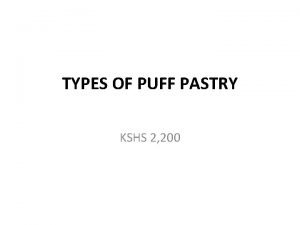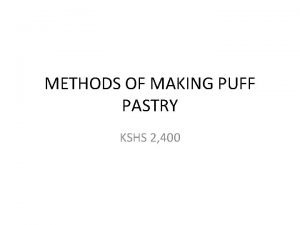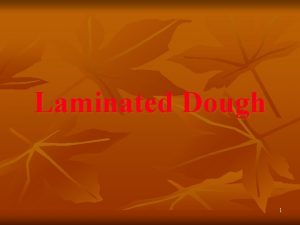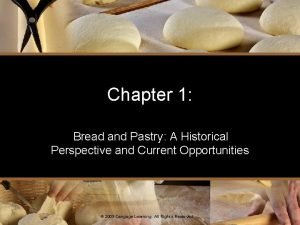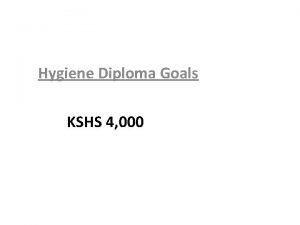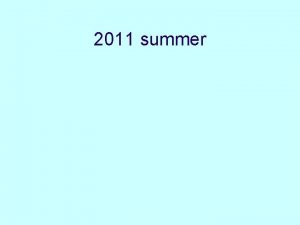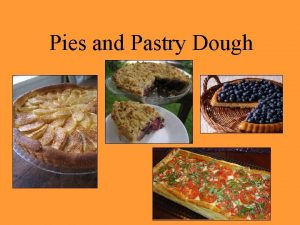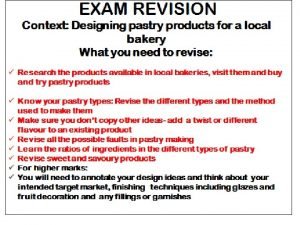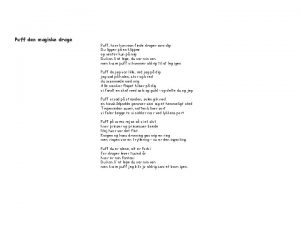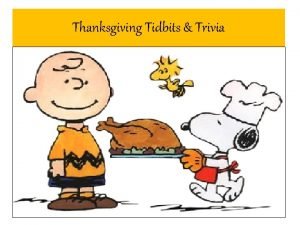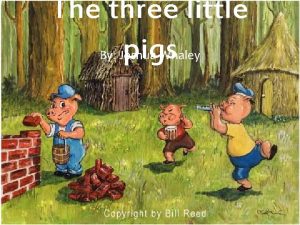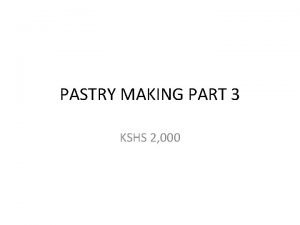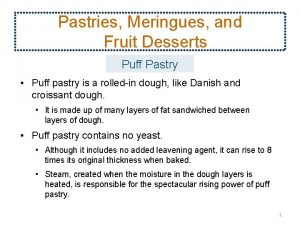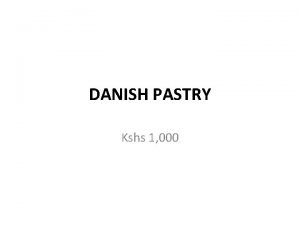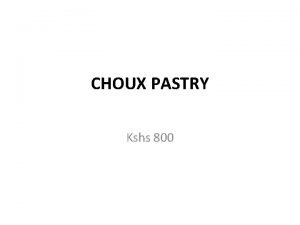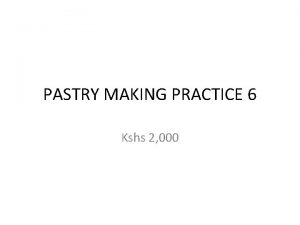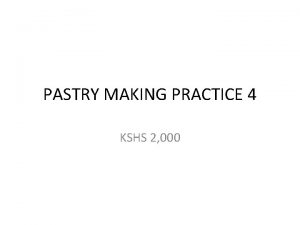METHODS OF MAKING PUFF PASTRY KSHS 2 400












- Slides: 12

METHODS OF MAKING PUFF PASTRY KSHS 2, 400

PUFF PASTRY • This Chapter covers the competencies required to produce pastry products. It involves objectives, methods of making puff pastry, selection and role of materials, types of puff pastry, varieties of puff pastry products, lamination and aeration. It also has test questions at the end of the chapter. OBJECTIVES: Ø At the end of this Chapter, the learner will be able to: Ø Describe the various methods used for making puff pastry. Ø Select appropriate materials for puff paste. Ø Understand the role of ingredients in puff pastry. Ø Understand the principles of aeration in puff pastry. Ø Describe the effects of incorrect layering on baked products. Ø Understand the suitability of paste for particular product types. Ø Know the procedures used for utilising cuttings/trimmings

METHODS OF MAKING PUFF PASTRY RECIPE The recipe below shows the normal quantity for making ‘full paste’. Three quarter or half paste is produced by using three quarters or half the total pastry fats shown in the recipe for ‘Full paste’. Ø 2 Kgs - Strong Flour Ø 0. 25 Kgs – butter (or cake margarine) Ø 10 gms - squeeze of lemon juice Ø 1. 15 litres water Ø 1. 5 Kgs tough butter or pastry margarine Ø Egg Colour

THERE ARE THREE DISTINCT METHODS OF MAKING PUFF PASTRY FRENCH METHOD Ø In this method the dough is pinned out to a square, the pastry fat is then placed on the dough in a cross cornered position. The pastry ends are then folded in envelope fashion to cover the fat. Ø Another method is to mould the dough round to a ball shape. Using a sharp knife cut the top into four. Spread out the ends of the cut portions into an envelope appearance. Work on the pastry margarine to make it pliable. Form it into a square and place it into the envelope shaped dough. The pastry dough ends are then folded in the envelope fashion to cover the pastry margarine. It is pinned out into a rectangle and folded one third over the two thirds. Give it the number of half turns that suit the type of product needed

In most cases however, the dough is pinned to a rectangle. Pastry fat added to cover half and the dough side is folded over. Ø Sieve the flour on the slab and rub in the cake margarine Ø Make a bay Ø Add the water, lemon juice and the egg colour into the bay Ø Mix to a nice clear dough Ø Dust up and mould lightly into a ball Ø Cover with a damp cloth to prevent skinning Ø Weigh the butter or pastry margarine Ø Mould it about on the slab to bring it to a homogenous, plastic condition Ø Finish by moulding it to a compact block Ø Pin out the dough to form a rectangle about half inch thick

Ø Pin out the four sides of the rectangle rather more thinly. Ø You will have a fairly thick central rectangle of dough having four thinner flaps at the sides. Ø Pin out the block of butter or pastry margarine to the same size as the thick central rectangle of dough Ø Place it upon the dough Ø Fold the four side-flaps over to enclose the fat so that the whole now takes the formation of an envelope of dough completely enclosing it. Ø With firm and even pressure on the rolling pin roll out the paste to a rectangle Ø Brush off all adhering flour Ø Fold one end over two thirds along the rectangle Ø Fold the opposite end of the piece of paste to cover the first fold Ø We have a rectangle consisting of 3 layers of pastry margarine, separated by layers of dough

Ø Ø Ø Ø Ø The paste is said to have received one half turn Turn the paste round on the slab Pin it out and once more fold it in three Brush off all surplus flour This completes the Full turn The paste now consists of nine layers of pastry margarine separated from each other by layers of dough Give the paste one hour rest in a cool place covered with a clean cloth to recover from rolling and folding The paste is then given another full turn (or 2 half turns) The paste consists of 81 layers of pastry margarine insulated from each other by dough. Give a rest of I hour

Ø Give it another full turn (or 2 half turns) Ø Give a rest of I hour. Ø Cut into small goods. Ø Theoretically the paste contains 729 layers of pastry margarine insulated from each other by layers of dough.

ENGLISH METHOD The dough preparation is the same for this as for the French Method. The dough is pinned out to a rectangle, the pastry fat is then placed on the dough covering two thirds, it is then folded into three. Ø The dough is then rolled out to a rectangle. Ø The pastry Margarine is broken up into small parts and these are evenly distributed to cover two-thirds of the area of the paste Ø The untreated third is folded over to cover half of the treated area and then folded over again to cover the last portion Ø Therefore we have two layers of dispersed margarine parts separated by layers of dough

Ø Pin out or roll out the paste again then fold the ends to the centre and fold over once more Ø This is called ‘four-fold turning’ and the formation of the paste consists of eight layers of Margarine insulated from one other with layers of dough. Ø Another four fold turning gives 32 layers of margarine Ø Give 1 hour rest. Ø Give it two more ‘four-fold turns’ to produce a structure containing 512 layers of margarine Ø Abetter paste is produced if , following the 1 hr rest the paste is rolled(pinned) to a rectangle and simply folded in two to produce 1024 layers of margarine. Ø This paste should now be given a further resting period before being cut out into the required varieties of pastries

SCOTCH METHOD • In this method the pastry fat is cut into cubes and added with the dry materials before adding the water. The dough is then mixed just sufficiently to form a clear dough but keeping the pieces of pastry fat as whole as possible. This results in a dough with lumps of pastry fat spread through it. It is then allowed to rest before turning.

Ø Rub the cake margarine into the sieved flour Ø Cut up the homogenous block of pastry margarine into small cubes and mix these loosely with the flour Ø Add the water, egg colour and mix all to lumpy kind of past Ø Pin out to a rectangle. Ø Proceed to give the usual number of turns interspersed with resting periods Ø In practice the individual lumps of pastry margarine become pinned out into thin flaky layers producing the laminated structure. Ø An extra half turn is given to puff paste made by scotch method to allow the first half turn to act as a ‘clearer
 Types of puff pastry
Types of puff pastry Puf hvor kan man finde
Puf hvor kan man finde English method puff pastry adalah
English method puff pastry adalah Blitz puff pastry definition
Blitz puff pastry definition 600+800+800
600+800+800 Pastry pastry
Pastry pastry Kshs term dates
Kshs term dates Methods of portion control in bread and pastry
Methods of portion control in bread and pastry What is the goal when making a pastry dough
What is the goal when making a pastry dough Choux pastry faults
Choux pastry faults Puff den magiske drage
Puff den magiske drage Why do turkeys puff up
Why do turkeys puff up Huff puff blow
Huff puff blow
